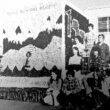One of the problems with news today is that follow-up sometimes gets short shrift.
Often a story will get reported and then you never hear about it again. It’s a problem with every news organization, at all levels.
There are a couple of reasons for this. One is that news is, well, news. And it becomes less newsy as the story develops. So sometimes an ongoing story may get overlooked as other things come along that get more priority.
Another problem, especially for us here at The New Era, is that we usually have way more stories that need to be covered than we have reporters. There have been many stories we would have liked to do more follow-up on, but have been unable to simply because there was so much more to cover.
But here’s some follow-up.
A few months ago – March 29 to be exact, we wrote about how a Sweet Home man, Clint McCraven, discovered pieces of an old flintlock pistol in the bank of Quartzville Creek. Shortly thereafter, our outdoors columnist, Shane Ullrich, told how a guy in his barbershop told him about a gun being thrown into the creek during a fight over a woman.
Recently, I had a chance to learn more about that incident. I called Clifford Wolfer, who used to haul logs up in the Quartzville area back in the day.
Wolfer, who is 93, told me that he was hauling logs in the winter during the early 1940s at the end of Quartzville Road, where the old stamp mill was. The road was so narrow that, at one point, one of his rear trailer dual tires would hang over the edge as he drove around a corner in the Packer’s Gulch area.
“I was the only one that hauled out of there most of the winter,” Wolfer said. “I made two trips a day to Lebanon.”
Wolfer said a man named Harry – he can’t recall the last name – from Ohio, had a place north of what today is Green Peter Dam. Harry, who was tall and lean and had a long white beard, would walk to town for supplies and sometimes rode along with Wolfer. Harry lived alone, though he told Wolfer he had a wife “back east somewhere.”
Wolfer said trouble started when Harry walked to town and stopped in at a shack occupied by a fellow named Oscar Chambers and his wife.
Harry stopped in and asked Chambers’ wife if she needed anything from town.
“Chambers thought Harry was trying to get his wife,” Wolfer said. “He came up with a gun to Harry’s place, and they got in a fight. Harry took the gun away from him and threw it in the river. He never did say what kind of gun it was.”
Wolfer said Harry told him Chambers ended up in jail after the incident.
It’s an interesting story, all right. Obviously, there are some details that make you wonder if the gun McCraven found was the one that got pitched into the drink by Harry. The pistol McCraven dug out of the mud, in several pieces, was a flintlock pistol local experts believe was made in the late 1700s or early 1800s.
You kind of wonder if Chambers would have used an old flintlock pistol, of all things, to teach Harry a lesson.
Also, McCraven dug the pistol he found out of Quartzville Creek, while Harry’s fight reportedly took place next to the Middle Santiam.
Still, it makes for a good story and who knows? Maybe there’s more to come.
* * * * *
Ever notice how, often, you can have a local attraction of some sort and many of the hometown folks have never been to it? When I lived in Southern California, there were literally hundreds of places I could have visited within an hour of my house –cultural, historical, educational points of interest including landmarks, museums, concert halls, and much, much more.
Yet, I never made it to most of them. I was too busy, you know, making a living, taking out the trash, building the room addition, that kind of thing.
My point is that a lot of great stuff happens right under our noses, things you can’t appreciate unless you experience them personally.
I was reminded of this on the Fourth of July when I went to the VFW Hall to shoot some pictures of the Banjo Camp performance there. Check out the photos on page 3 to see what I’m talking about.
Suffice to say, I was unprepared for the impact of walking into a hall where 80 banjo players were strumming in unison – excellent banjo players. You have to see this to believe it.
These people came from all over the United States, and two from Germany, to play their banjos at Ralph Martin’s place on North River Road for a few days. Martin has been holding these camps since 1982, first in Southern California, then here. The VFW Fourth-of-July performances have taken place for the past 10 years.
So I ask, have you ever been to one?
This isn’t the kind of music I normally listen to, but it’s good music –classic tunes from the ’30s and ’40s and earlier eras, played with gusto and with skill. These people take this seriously and they know what they’re doing.
It’s not just banjos. There were several tubas, a couple of guitars, a skilled clarinetist, a couple of washboards and a wash tub, some very decent vocal soloists and even a special number performed on a rubber chicken.
Want to get a little shot of what America is all about on a Fourth of July? This is the place to be. But be warned: Get there early or it’ll be standing room only.




